
Title: Innovative Catalyst Enables Stereoselective Control in Radical Amination Reactions
A significant advancement in asymmetric synthesis tackles a historic obstacle in radical chemistry: the formation of highly enantioenriched α-chiral alkyl amines from prochiral di-alkyl radicals. A team of researchers headed by Xin-Yuan Liu at the Southern University of Science and Technology in China has crafted a groundbreaking catalyst system that utilizes a meticulously designed metal–ligand complex to achieve effective stereocontrol, even in the presence of structurally analogous alkyl substituents.
Radical intermediates—atoms or molecules characterized by unpaired electrons—are extensively utilized in synthetic organic chemistry due to their elevated reactivity and capacity to facilitate challenging transformations under mild conditions. Nevertheless, their extreme reactivity poses a double-edged challenge. While radicals can readily perform numerous chemical transformations, managing the outcomes—particularly the spatial configuration or “handedness” (chirality) of the resultant products—has proven to be exceedingly difficult, especially for prochiral di-alkyl radicals that have similar substituents.
“Achieving selectivity among nearly indistinguishable groups such as methyl and ethyl has consistently posed one of the largest hurdles in stereoselective radical chemistry,” Liu remarks. “The inclination of these species to partake in uncontrolled, racemic background reactions, coupled with their inherently flat energy profiles, renders traditional stereocontrol strategies ineffective.”
Inspired by Nature
The team drew inspiration from enzymatic systems, which consistently execute highly selective reactions by precisely positioning substrates within active sites that favor one reaction pathway over others. Imitating this principle, Liu and collaborators crafted a conical-shaped metal–ligand pocket surrounding a copper core to function as a micro-reactor. This precisely defined pocket not only secures the radical intermediate in a fixed alignment but also distinguishes between similarly sized alkyl groups through subtle steric and non-covalent interactions.
“Within this engineered cavity,” states Liu, “smaller groups like methyl occupy tighter spaces while bulkier groups are displaced outward. Larger substituents near the pocket’s edge further direct the reaction through weak, yet influential, interactions such as van der Waals forces or aromatic stacking.”
Stereoselective Radical Amination
Employing this methodology, the team formulated an asymmetric amination reaction utilizing established copper catalysis. Throughout the reaction, a sulfoximine group—a nitrogen-containing functional group—was selectively appended to prochiral di-alkyl radicals to yield α-chiral alkyl amines. These amines are abundant in bioactive compounds and pharmaceutical agents, rendering the methodology especially advantageous for drug discovery initiatives.
The reaction demonstrated versatility across a broad substrate range, accommodating various alkyl and cycloalkyl radical precursors and producing over 50 distinct high-value chiral amines with up to 96% enantiomeric excess (ee). Notably, the system was capable of distinguishing between nuanced substituents like methyl versus ethyl or ethyl versus propyl—an accomplishment infrequently observed with radical intermediates.
“This is an outstanding outcome,” notes Dr. Mattia Silvi, a specialist in asymmetric radical chemistry at the University of Nottingham. “The degree of selectivity attained between closely related alkyl groups, particularly between ethyl and propyl, highlights the effectiveness of this catalyst design.” Silvi further indicates that the team’s meticulous focus on pocket architecture and ligand design emulates enzyme-like precision and may inspire comparable frameworks for other complex stereoselective transformations.
Future Prospects and Development
The ramifications of this investigation extend far beyond amination chemistry. Chiral alkyl amines serve as essential motifs in agrochemicals, medicinal substances, and materials science, and the capacity to generate them with efficiency and selectivity could enhance the development of diverse molecular libraries. More broadly, the success of this strategy indicates that metal-catalyzed radical reactions can be guided under stereocontrol with carefully constructed catalysts.
“Looking forward, we aim to extend beyond this amination to develop additional bond-forming processes,” Liu expresses. “Specifically, we seek to involve unactivated trialkyl-substituted alkyl radicals in asymmetric transformations. These present even more structural similarities and challenges, but the prospective worth of the resulting chiral molecules justifies the effort.”
This research not only demonstrates a viable synthetic approach for managing notoriously challenging radical reactions but also signifies a substantial leap toward integrating enzymatic precision into transition-metal catalysis. As more chemists examine such catalyst architectures, stereoselective radical chemistry may soon transform into a regular tool in the chemist’s toolkit.
References:
– Xin-Yuan Liu’s Research Group: https://liuxy.chem.sustech.edu.cn/
– Mattia Silvi, University of Nottingham: https://silviresearch.com/